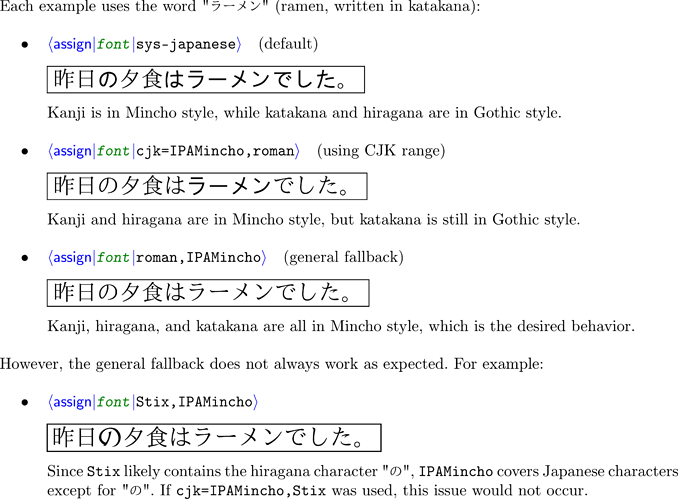I tried the latest versions of TeXmacs and Mogan STEM on Windows 11, and the developing version of TeXmacs on WSL. When I set the language to Japanese and started typing, kanji and hiragana were rendered in Mincho style (same font), while katakana appeared in Gothic style (a different font). Furthermore, in the beamer template, katakana appeared smaller than kanji and hiragana.
Looking into the source code, I found the following section in smart_font.cpp
string
get_unicode_range (int code) {
if (code <= 0x7f) return "ascii";
else if (code >= 0x80 && code <= 0x37f) return "latin";
else if (code >= 0x380 && code <= 0x3ff) return "greek";
else if (code >= 0x400 && code <= 0x4ff) return "cyrillic";
else if (code >= 0x3000 && code <= 0x303f) return "cjk";
else if (code >= 0x4e00 && code <= 0x9fcc) return "cjk";
else if (code >= 0xff00 && code <= 0xffef) return "cjk";
else if (code >= 0x3040 && code <= 0x309F) return "hiragana";
else if (code >= 0xac00 && code <= 0xd7af) return "hangul";
else if (code >= 0x2000 && code <= 0x23ff) return "mathsymbols";
else if (code >= 0x2900 && code <= 0x2e7f) return "mathextra";
else if (code >= 0x1d400 && code <= 0x1d7ff) return "mathletters";
else return "";
}
The Unicode range for katakana is 0x30A0–0x30FF, but it doesn’t seem to be included anywhere. Is there a particular reason for this design?

